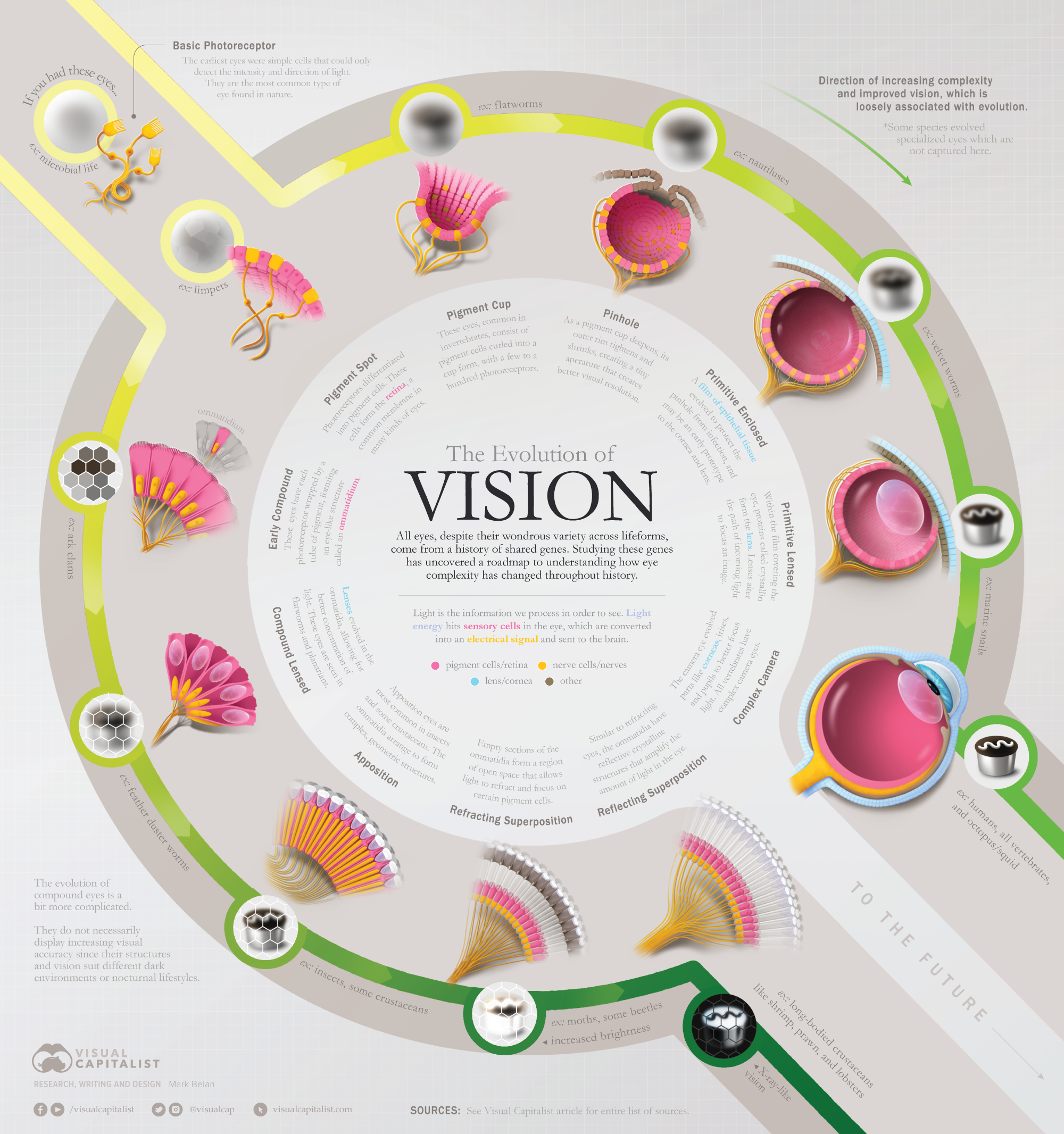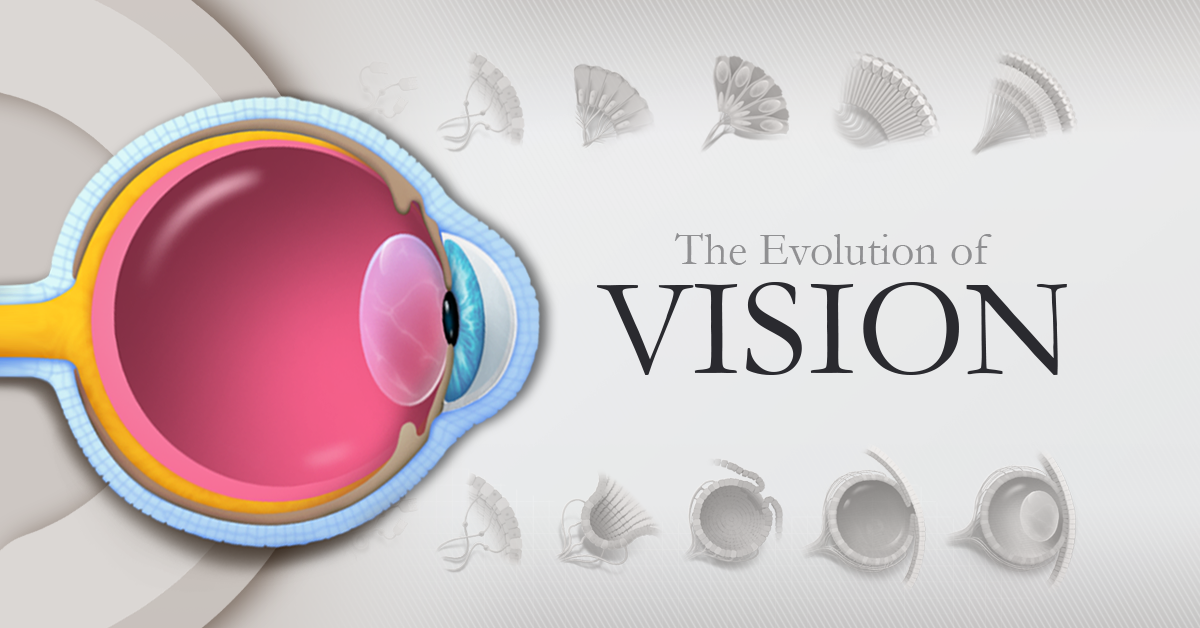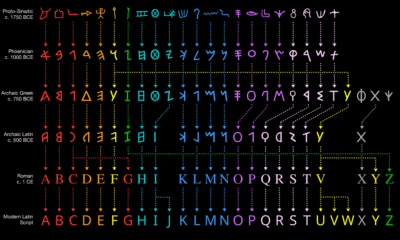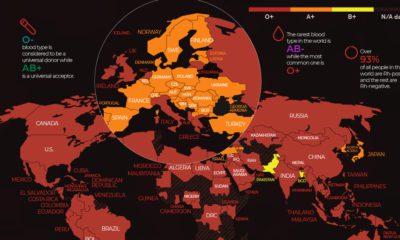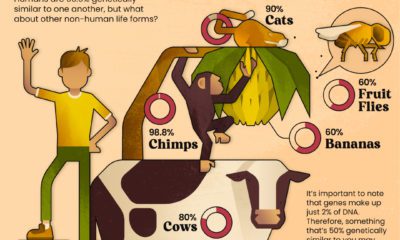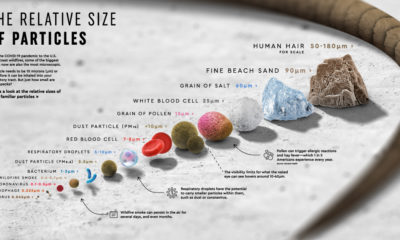Misc
Visualizing the Evolution of Vision and the Eye
View the high-resolution version of this graphic.
Roadmapping the Evolution of the Eye
Throughout history, numerous creatures have evolved increasingly complex eyes in response to different selective pressures.
Not all organisms, however, experience the same pressures. It’s why some creatures today still have eyes that are quite simple, or why some have no eyes at all. These organisms exemplify eyes that are “frozen” in time. They provide snapshots of the past, or “checkpoints” of how the eye has transformed throughout its evolutionary journey.
Scientists study the genes, anatomy, and vision of these creatures to figure out a roadmap of how the eye came to be. And so, we put together an evolutionary graphic timeline of the eye’s different stages using several candidate species.
Let’s take a look at how the eye has formed throughout time.
Where Vision Comes From
The retina is a layer of nerve tissue, often at the back of the eye, that is sensitive to light.
When light hits it, specialized cells called photoreceptors transform light energy into electrical signals and send them to the brain. Then the brain processes these electrical signals into images, creating vision.
The earliest form of vision arose in unicellular organisms. Containing simple nerve cells that can only distinguish light from dark, they are the most common eye in existence today.
The ability to detect shapes, direction, and color comes from all of the add-ons evolution introduces to these cells.
Two Major Types of Eyes
Two major eye types are dominant across species. Despite having different shapes or specialized parts, improved vision in both eye types is a product of small, gradual changes that optimize the physics of light.
Simple Eyes
Simple eyes are actually quite complex, but get their name because they consist of one individual unit.
Some mollusks and all of the higher vertebrates, like birds, reptiles, or humans, have simple eyes.
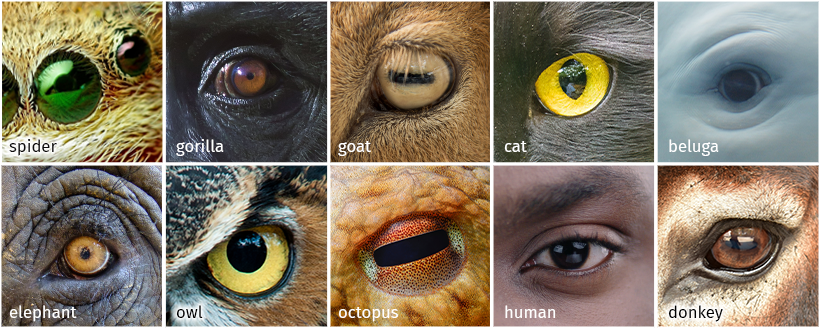
Simple eyes evolved from a pigment cup, slowly folding inwards with time into the shape we recognize today. Specialized structures like the lens, cornea, and pupil arose to help improve the focus of light on the retina. This helps create sharper, clearer images for the brain to process.

Compound Eyes
Compound eyes are formed by repeating the same basic units of photoreceptors called ommatidia. Each ommatidium is similar to a simple eye, composed of lenses and photoreceptors.
Grouped together, ommatidia form a geodesic pattern that is commonly seen in insects and crustaceans.
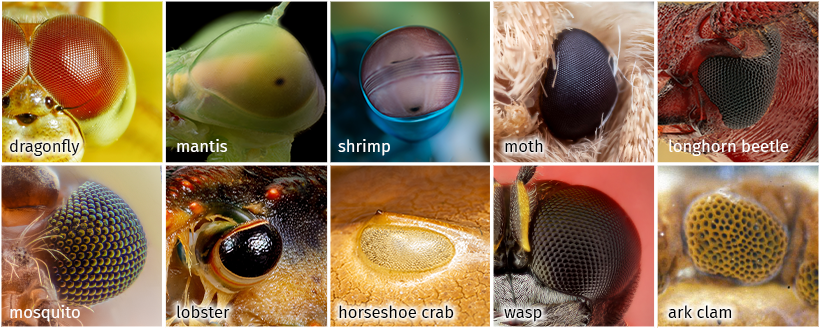
Our understanding of the evolution of the compound eye is a bit murky, but we know that rudimentary ommatidia evolved into larger, grouped structures that maximize light capture.

In environments like caves, the deep subsurface, or the ocean floor where little to no light exists, compound eyes are useful for producing vision that gives even the slightest advantage over other species.
How Will Vision Evolve?
Our increasing dependency on technology and digital devices may be ushering in the advent of a new eye shape.
The muscles around the eye stretch to shift the lens when staring at something close by. The eye’s round shape elongates in response to this muscle strain.
Screen time with cellphones, tablets, and computers has risen dramatically over the years, especially during the COVID-19 pandemic. Recent studies are already reporting rises in childhood myopia, the inability to see far away. Since the pandemic, cases have increased by 17%, affecting almost 37% of schoolchildren.
Other evolutionary opportunities for our eyes are currently less obvious. It remains to be seen whether advanced corrective therapies, like corneal transplants or visual prosthetics, will have any long-term evolutionary impact on the eye.
For now, colored contacts and wearable tech may be our peek into the future of vision.
Complete Sources
Fernald, Russell D. “Casting a Genetic Light on the Evolution of Eyes.” Science, vol. 313, no. 5795, 29 Sept. 2006, pp. 1914–1918
Gehring, W. J. “New Perspectives on Eye Development and the Evolution of Eyes and Photoreceptors.” Journal of Heredity, vol. 96, no. 3, 13 Jan. 2005, pp. 171–184. Accessed 18 Dec. 2019.
“The Evolution of Sight | PHOS.”
Land, Michael F, and Dan-Eric Nilsson. Animal Eyes. Oxford ; New York, Oxford University Press, 2002.
“The Major Topics of the Research Work of Prof. Dan-E. Nilsson: Vision-Research.eu – the Gateway to European Vision Research.” Accessed 3 Oct. 2022.
Misc
How Hard Is It to Get Into an Ivy League School?
We detail the admission rates and average annual cost for Ivy League schools, as well as the median SAT scores required to be accepted.

How Hard Is It to Get Into an Ivy League School?
This was originally posted on our Voronoi app. Download the app for free on iOS or Android and discover incredible data-driven charts from a variety of trusted sources.
Ivy League institutions are renowned worldwide for their academic excellence and long-standing traditions. But how hard is it to get into one of the top universities in the U.S.?
In this graphic, we detail the admission rates and average annual cost for Ivy League schools, as well as the median SAT scores required to be accepted. The data comes from the National Center for Education Statistics and was compiled by 24/7 Wall St.
Note that “average annual cost” represents the net price a student pays after subtracting the average value of grants and/or scholarships received.
Harvard is the Most Selective
The SAT is a standardized test commonly used for college admissions in the United States. It’s taken by high school juniors and seniors to assess their readiness for college-level academic work.
When comparing SAT scores, Harvard and Dartmouth are among the most challenging universities to gain admission to. The median SAT scores for their students are 760 for reading and writing and 790 for math. Still, Harvard has half the admission rate (3.2%) compared to Dartmouth (6.4%).
| School | Admission rate (%) | SAT Score: Reading & Writing | SAT Score: Math | Avg Annual Cost* |
|---|---|---|---|---|
| Harvard University | 3.2 | 760 | 790 | $13,259 |
| Columbia University | 3.9 | 750 | 780 | $12,836 |
| Yale University | 4.6 | 760 | 780 | $16,341 |
| Brown University | 5.1 | 760 | 780 | $26,308 |
| Princeton University | 5.7 | 760 | 780 | $11,080 |
| Dartmouth College | 6.4 | 760 | 790 | $33,023 |
| University of Pennsylvania | 6.5 | 750 | 790 | $14,851 |
| Cornell University | 7.5 | 750 | 780 | $29,011 |
*Costs after receiving federal financial aid.
Additionally, Dartmouth has the highest average annual cost at $33,000. Princeton has the lowest at $11,100.
While student debt has surged in the United States in recent years, hitting $1.73 trillion in 2023, the worth of obtaining a degree from any of the schools listed surpasses mere academics. This is evidenced by the substantial incomes earned by former students.
Harvard grads, for example, have the highest average starting salary in the country, at $91,700.
-

 Real Estate2 weeks ago
Real Estate2 weeks agoVisualizing America’s Shortage of Affordable Homes
-

 Technology1 week ago
Technology1 week agoRanked: Semiconductor Companies by Industry Revenue Share
-

 Money2 weeks ago
Money2 weeks agoWhich States Have the Highest Minimum Wage in America?
-

 Real Estate2 weeks ago
Real Estate2 weeks agoRanked: The Most Valuable Housing Markets in America
-

 Business2 weeks ago
Business2 weeks agoCharted: Big Four Market Share by S&P 500 Audits
-

 AI2 weeks ago
AI2 weeks agoThe Stock Performance of U.S. Chipmakers So Far in 2024
-

 Misc2 weeks ago
Misc2 weeks agoAlmost Every EV Stock is Down After Q1 2024
-

 Money2 weeks ago
Money2 weeks agoWhere Does One U.S. Tax Dollar Go?

